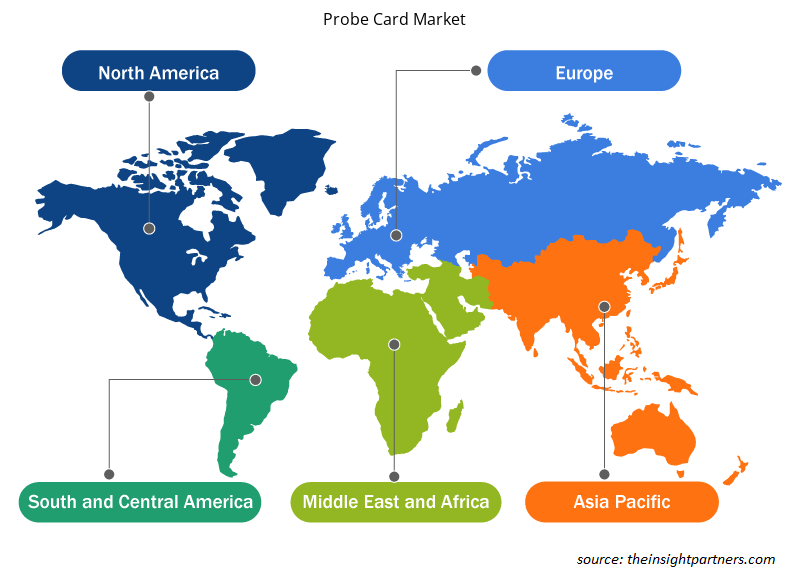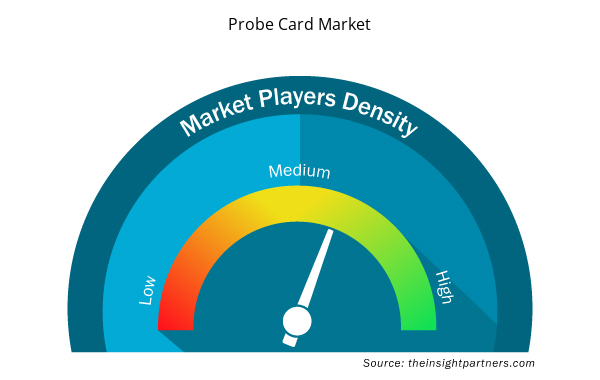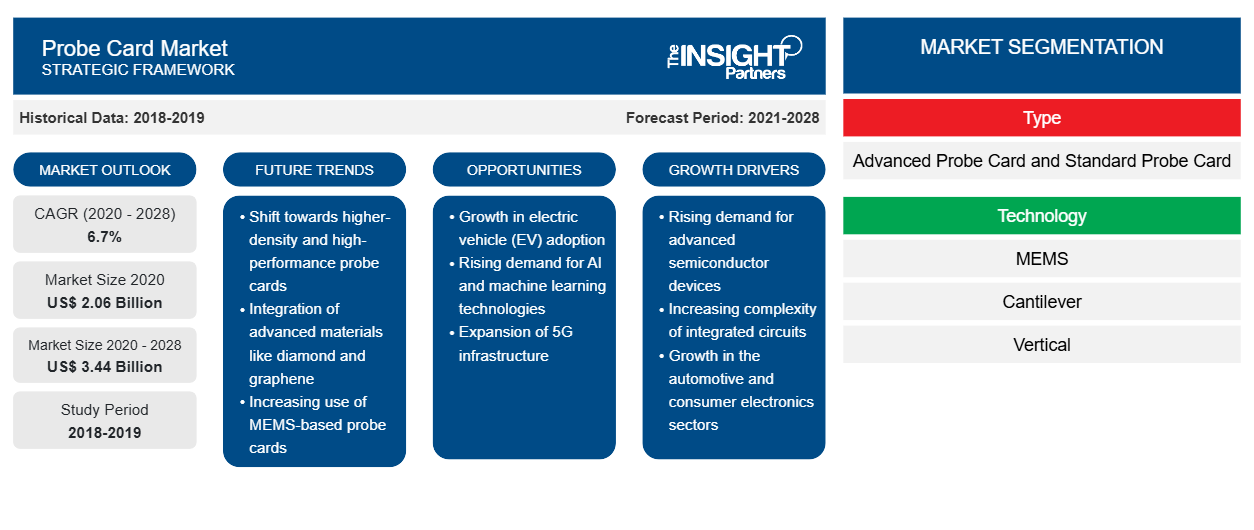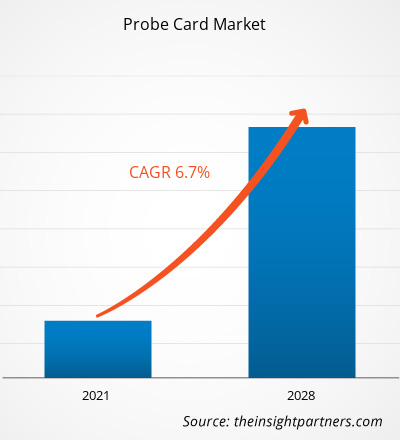プローブカード市場規模は、2020年の20億5,980万米ドルから2028年には34億3,680万米ドルに達すると予測されており、2021年から2028年にかけて6.7%のCAGRで健全な市場成長が見込まれています。
プローブ カードは、半導体ウェーハをテストするためのインターフェイスです。半導体製造の初期段階では、この手順を使用して集積回路の品質や潜在的意味インデックスを評価します。ほとんどの場合、プローブ カードはプローバに機械的にドッキングされ、テスターに電気的にリンクされます。プローブ カードの主な目的は、テスト装置とウェーハ上の回路の間に電気的な接続を確立し、回路をテストできるようにすることです。プリント回路基板 (PCB) とさまざまなタイプの接触要素が、プローブ カードの基本コンポーネントです。プローブ カードでは、非常に一般的な要素もあれば、非常に特殊な用途を持つ要素もある、さまざまな要素が考慮されます。
携帯電話、デスクトップ、デジタルカメラ、タブレット、ラップトップ、ハードドライブ、テレビなどの使用の増加、および新技術の絶え間ない研究と導入の結果として、コンシューマーエレクトロニクス事業は進化してきました。スマートガジェットとモノのインターネットの導入、タブレットの普及拡大、大画面デバイスの需要急増はすべて、プローブ市場の成長に貢献しています。半導体の需要は、チップサイズのトレンドの変化と、さまざまな電子製品におけるクリエイティブなアーキテクチャの好みの高まりによって促進されてきました。ICチップ製造の規模の拡大により、電子機器テストの需要が急増し、プローブカードの需要が高まっています。AIやIoTなどの最新技術が半導体製造装置に組み込まれることで、製造施設での受け入れが加速します。さらに、IoTデバイス用のシリコンベースのセンサーの需要増加、新興国でのチップ業界の存在感の拡大、データセンターとサーバーの増加は、半導体業界のパフォーマンスを向上させる要因であり、プローブカードの需要に貢献しています。
ウイルス感染を最小限に抑えるための世界的なロックダウンにより、特に中小企業の経営者を中心に、多くのメーカーのサプライチェーン活動と生産量に大きな混乱が生じています。産業部門とエンドユーザーからの電子部品の需要が低下したため、半導体業界は大きな打撃を受けました。ロックダウン期間中は大量生産が行われなかったため、マイクロエレクトロニクスの収益モデルは低下しました。ロックダウン後、生産施設が社会的距離を保つ対策を講じて操業を再開したため、半導体業界は市場シェアを取り戻し始めました。さらに、在宅勤務やリモートモニタリング戦略も、接続性を高めた高度な電子製品の販売増加に貢献しました。ITおよび通信業界の重要性は通信目的で強調されており、これにより、業界はIoT接続や高速Wi-Fi互換パッケージング技術などの新技術で進化することができました。
要件に合わせてレポートをカスタマイズする
このレポートの一部、国レベルの分析、Excelデータパックなど、あらゆるレポートを無料でカスタマイズできます。また、スタートアップや大学向けのお得なオファーや割引もご利用いただけます。
- このレポートの主要な市場動向を入手してください。この無料サンプルには、市場動向から見積もりや予測に至るまでのデータ分析が含まれます。
プローブカード市場レポートによると、アジア太平洋地域は世界のプローブカード市場シェアの大部分を占めると予想されています。アジア太平洋地域は、中国、インド、日本、オーストラリア、韓国など、最大かつ最もダイナミックな経済で構成されています。台湾、中国、日本は、アジア太平洋地域の主要な半導体製造国です。インドや中国などの発展途上国での可処分所得の増加は、スマートウェアラブル、スマートフォン、電気自動車などのハイテク家電製品の大規模な顧客基盤につながっています。この要因は、この地域のプローブカード市場を牽引すると予想されます。中国は、ICパッケージング技術ベースの製品の主要な製造拠点であり、台湾、韓国、日本も地域市場の成長に大きく貢献しています。アジア太平洋諸国の多くは、民生用電子機器、自動車部品、通信機器、その他の産業機械に必要な電子機器の大量生産を特徴としています。熟練した人材が豊富にあるため、インドと中国で電子機器製造会社が増加しており、プローブカード市場の成長を牽引しています。
プローブカード市場セグメント
プローブカード市場分析に基づいて、市場はタイプ、テクノロジー、アプリケーション、および地域に分割されています。タイプに基づいて、プローブカード市場は高度なプローブカードと標準プローブカードに分割されています。テクノロジーに基づいて、プローブカード市場はMEMS、カンチレバー、および垂直に分割されています。また、アプリケーションに基づいて、プローブカード市場はファウンドリとロジック、DRAM、フラッシュ、その他に分割されています。地理的分析は、北米、ヨーロッパ、アジア太平洋(APAC)、その他の地域(RoW)などの地域に基づいて行われます。
プローブカード市場の主要プレーヤーとしては、FEINMETALL GmbH、FormFactor、富士通、GGB Industries、日本電子材料株式会社、Korea Instrument Co.,Ltd.、Micronics Japan Co., Ltd.、MPI Corporation、SV Probe、Technoprobe SpAなどが挙げられます。
タイプベースのプローブカード市場の洞察
タイプに基づいて、世界のプローブ カード市場は、高度なプローブ カードと標準プローブ カードに分類されます。プローブ カードは、半導体ウェーハのウェーハ テストを実行するために使用されるインターフェイスまたはボードです。プローブ カードを使用して実行されるテストには、基本的に DC テスト、AC テスト、および機能テストの 3 種類があります。
プローブカード市場の地域別分析
予測期間を通じてプローブ カード市場に影響を与える地域的な傾向と要因は、Insight Partners のアナリストによって徹底的に説明されています。このセクションでは、北米、ヨーロッパ、アジア太平洋、中東、アフリカ、南米、中米にわたるプローブ カード市場のセグメントと地理についても説明します。

- プローブカード市場の地域別データを入手
プローブカード市場レポートの範囲
| レポート属性 | 詳細 |
|---|---|
| 2020年の市場規模 | 20.6億米ドル |
| 2028年までの市場規模 | 34億4千万米ドル |
| 世界のCAGR(2020年 - 2028年) | 6.7% |
| 履歴データ | 2018-2019 |
| 予測期間 | 2021-2028 |
| 対象セグメント | タイプ別
|
| 対象地域と国 | 北米
|
| 市場リーダーと主要企業プロフィール |
|
市場プレーヤーの密度:ビジネスダイナミクスへの影響を理解する
プローブ カード市場は、消費者の嗜好の変化、技術の進歩、製品の利点に対する認識の高まりなどの要因により、エンド ユーザーの需要が高まり、急速に成長しています。需要が高まるにつれて、企業は提供内容を拡大し、消費者のニーズを満たすために革新を起こし、新たなトレンドを活用し、市場の成長をさらに促進しています。
市場プレーヤー密度とは、特定の市場または業界内で活動している企業または会社の分布を指します。これは、特定の市場スペースに、その規模または総市場価値と比較して、どれだけの競合相手 (市場プレーヤー) が存在するかを示します。
プローブカード市場で事業を展開している主要企業は次のとおりです。
- ファインメタル株式会社
- フォームファクター株式会社
- 富士通
- GGBインダストリーズ
- 日本電子材料株式会社
免責事項:上記の企業は、特定の順序でランク付けされていません。

- プローブカード市場のトップキープレーヤーの概要を入手
プローブ カード市場レポートで紹介されている企業は、主に高度で効率的な製品の開発に重点を置いています。プローブ カード市場の企業は、プローブ カード市場における技術の進歩に合わせてさまざまな戦略を実施しています。
- 2020 年、FormFactor は新興コンピューティング アプリケーション向けの Cryogenic Probe ファミリを発表しました。
- 2020年に、TechnoprobeはMicrofabricaを買収しました。
- 過去2年間の分析、基準年、CAGRによる予測(7年間)
- PEST分析とSWOT分析
- 市場規模価値/数量 - 世界、地域、国
- 業界と競争環境
- Excel データセット



Report Coverage
Revenue forecast, Company Analysis, Industry landscape, Growth factors, and Trends

Segment Covered
This text is related
to segments covered.

Regional Scope
North America, Europe, Asia Pacific, Middle East & Africa, South & Central America

Country Scope
This text is related
to country scope.
よくある質問
Increasing penetration of consumer electronics and rise in manufacturing of semiconductor chips due to proliferating automotive sector are driving the growth of the global probe card market.
On the basis of type segment, the probe card market is segmented into advanced probe card and standard probe card. The advanced probe card segment led the global probe card market with a market share of 77.5% in 2020. Further, it is expected to garner 80.2% share by 2028.
APAC led the market with a highest revenue share in 2020, and it is also expected to register the fastest CAGR during the forecast period. China, Japan, and South Korea are among the major contributors to the probe card market growth in APAC. The electronics industries in China and Japan represent huge potential for the manufacturing and sale of probe card devices. Similarly, many APAC countries are characterized by the mass production of electronic components required for consumer electronics, automotive devices, telecommunication devices, and other industrial machinery. Rising number of electronics manufacturing companies in India and China owing to the availability of skilled human resources is driving the probe card market growth. The growing production of ICs in APAC is also another factor driving the probe card market growth.
Trends and growth analysis reports related to Electronics and Semiconductor : READ MORE..
The List of Companies - Probe Card Market
- FEINMETALL GmbH
- FormFactor, Inc.
- Fujitsu
- GGB Industries
- Japan Electronic Materials Corporation
- Korea Instrument Co., Ltd.
- MPI Corporation
- SV Probe
- Technoprobe S.p.A.
- Micronics Japan Co., Ltd.
The Insight Partners performs research in 4 major stages: Data Collection & Secondary Research, Primary Research, Data Analysis and Data Triangulation & Final Review.
- Data Collection and Secondary Research:
As a market research and consulting firm operating from a decade, we have published and advised several client across the globe. First step for any study will start with an assessment of currently available data and insights from existing reports. Further, historical and current market information is collected from Investor Presentations, Annual Reports, SEC Filings, etc., and other information related to company’s performance and market positioning are gathered from Paid Databases (Factiva, Hoovers, and Reuters) and various other publications available in public domain.
Several associations trade associates, technical forums, institutes, societies and organization are accessed to gain technical as well as market related insights through their publications such as research papers, blogs and press releases related to the studies are referred to get cues about the market. Further, white papers, journals, magazines, and other news articles published in last 3 years are scrutinized and analyzed to understand the current market trends.
- Primary Research:
The primarily interview analysis comprise of data obtained from industry participants interview and answers to survey questions gathered by in-house primary team.
For primary research, interviews are conducted with industry experts/CEOs/Marketing Managers/VPs/Subject Matter Experts from both demand and supply side to get a 360-degree view of the market. The primary team conducts several interviews based on the complexity of the markets to understand the various market trends and dynamics which makes research more credible and precise.
A typical research interview fulfils the following functions:
- Provides first-hand information on the market size, market trends, growth trends, competitive landscape, and outlook
- Validates and strengthens in-house secondary research findings
- Develops the analysis team’s expertise and market understanding
Primary research involves email interactions and telephone interviews for each market, category, segment, and sub-segment across geographies. The participants who typically take part in such a process include, but are not limited to:
- Industry participants: VPs, business development managers, market intelligence managers and national sales managers
- Outside experts: Valuation experts, research analysts and key opinion leaders specializing in the electronics and semiconductor industry.
Below is the breakup of our primary respondents by company, designation, and region:

Once we receive the confirmation from primary research sources or primary respondents, we finalize the base year market estimation and forecast the data as per the macroeconomic and microeconomic factors assessed during data collection.
- Data Analysis:
Once data is validated through both secondary as well as primary respondents, we finalize the market estimations by hypothesis formulation and factor analysis at regional and country level.
- Macro-Economic Factor Analysis:
We analyse macroeconomic indicators such the gross domestic product (GDP), increase in the demand for goods and services across industries, technological advancement, regional economic growth, governmental policies, the influence of COVID-19, PEST analysis, and other aspects. This analysis aids in setting benchmarks for various nations/regions and approximating market splits. Additionally, the general trend of the aforementioned components aid in determining the market's development possibilities.
- Country Level Data:
Various factors that are especially aligned to the country are taken into account to determine the market size for a certain area and country, including the presence of vendors, such as headquarters and offices, the country's GDP, demand patterns, and industry growth. To comprehend the market dynamics for the nation, a number of growth variables, inhibitors, application areas, and current market trends are researched. The aforementioned elements aid in determining the country's overall market's growth potential.
- Company Profile:
The “Table of Contents” is formulated by listing and analyzing more than 25 - 30 companies operating in the market ecosystem across geographies. However, we profile only 10 companies as a standard practice in our syndicate reports. These 10 companies comprise leading, emerging, and regional players. Nonetheless, our analysis is not restricted to the 10 listed companies, we also analyze other companies present in the market to develop a holistic view and understand the prevailing trends. The “Company Profiles” section in the report covers key facts, business description, products & services, financial information, SWOT analysis, and key developments. The financial information presented is extracted from the annual reports and official documents of the publicly listed companies. Upon collecting the information for the sections of respective companies, we verify them via various primary sources and then compile the data in respective company profiles. The company level information helps us in deriving the base number as well as in forecasting the market size.
- Developing Base Number:
Aggregation of sales statistics (2020-2022) and macro-economic factor, and other secondary and primary research insights are utilized to arrive at base number and related market shares for 2022. The data gaps are identified in this step and relevant market data is analyzed, collected from paid primary interviews or databases. On finalizing the base year market size, forecasts are developed on the basis of macro-economic, industry and market growth factors and company level analysis.
- Data Triangulation and Final Review:
The market findings and base year market size calculations are validated from supply as well as demand side. Demand side validations are based on macro-economic factor analysis and benchmarks for respective regions and countries. In case of supply side validations, revenues of major companies are estimated (in case not available) based on industry benchmark, approximate number of employees, product portfolio, and primary interviews revenues are gathered. Further revenue from target product/service segment is assessed to avoid overshooting of market statistics. In case of heavy deviations between supply and demand side values, all thes steps are repeated to achieve synchronization.
We follow an iterative model, wherein we share our research findings with Subject Matter Experts (SME’s) and Key Opinion Leaders (KOLs) until consensus view of the market is not formulated – this model negates any drastic deviation in the opinions of experts. Only validated and universally acceptable research findings are quoted in our reports.
We have important check points that we use to validate our research findings – which we call – data triangulation, where we validate the information, we generate from secondary sources with primary interviews and then we re-validate with our internal data bases and Subject matter experts. This comprehensive model enables us to deliver high quality, reliable data in shortest possible time.


 このレポートの無料サンプルを入手する
このレポートの無料サンプルを入手する